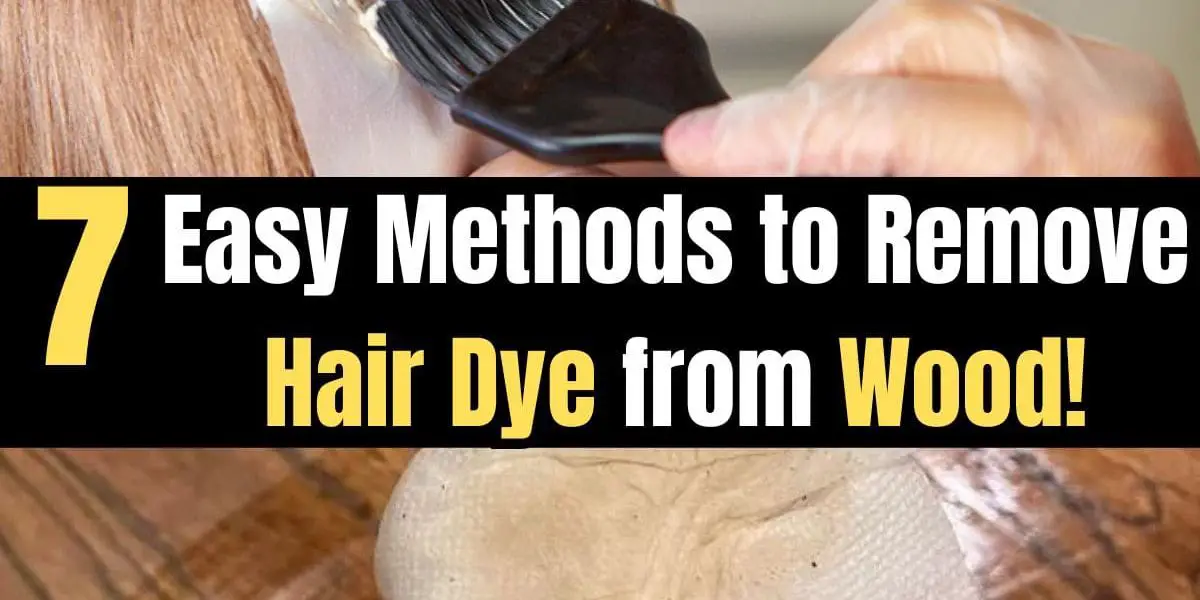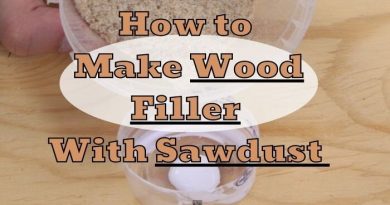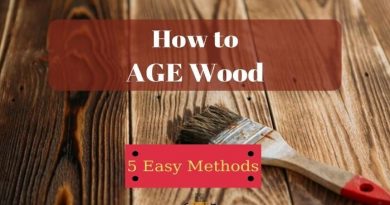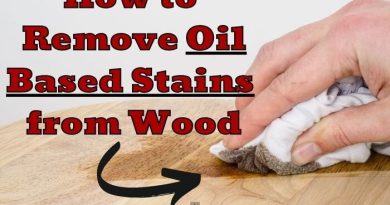7 Easy Methods to Remove Hair Dye from Wood Like a Pro!
| Wood Type | Furniture Type | Method to Remove Hair Dye from Wood |
|---|---|---|
| Softwood (e.g., Pine, Cedar) | Tables, Chairs | Baking Soda and Vinegar Mix |
| Hardwood (e.g., Oak, Maple) | Flooring, Cabinets | Baking Soda and Hydrogen Peroxide |
| Cherry Wood | Antique Furniture | Hairspray |
| Painted Wood | Shelving, Desks | Olive Oil and Salt Scrub |
| Laminated Wood | Kitchen Countertops, Bathroom Vanities | Nail Polish Remover (acetone-based) |
Natural Methods to Remove Hair Dye Stains from Wood
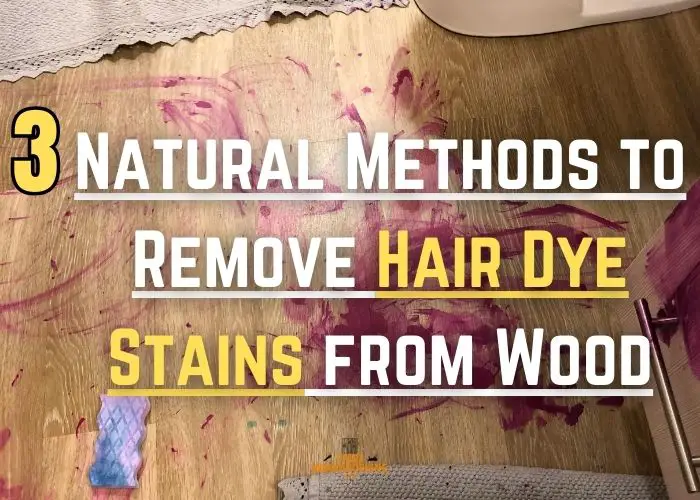
1. Using Baking Soda and Vinegar Mix
Step 1: Create the Paste
I start by making a paste with a 1:1 ratio of baking soda to vinegar. The consistency should be similar to toothpaste; thick enough to adhere to the wood without running. I prefer white vinegar for its cleaning power and because it’s less likely to discolor the wood compared to darker kinds of vinegar.
Step 2: Apply the Paste onto the Hair Dye Stain
With a clean cloth, I carefully apply the paste directly onto the hair dye stain, ensuring full coverage. I use a gentle touch to avoid scratching the wood’s surface. The natural abrasiveness of baking soda works in tandem with the acidic nature of vinegar to break down the dye molecules.
Step 3: Let It Work
Patience is key. I allow the paste to sit on the stain for about 15 minutes. During this time, the vinegar’s acidity helps to lift the stain from the wood, while the baking soda acts as a gentle scrubbing agent.
Step 4: Gentle Start Scrubbing
After the paste has had time to penetrate the stain, I use a soft-bristled brush or cloth to lightly scrub the area in a circular motion, following the grain of the wood. This action helps to release the stain from the wood pores without causing damage to the finish.
Step 5: Rinse and Dry the Wood Surface
Once I’m satisfied with the scrubbing, I wipe away the paste with a damp cloth, rinsing the area thoroughly to remove any residue. It’s important to be gentle to prevent water damage to the wood. Then, I immediately dry the area with a clean, dry towel to prevent any moisture from soaking in.
Step 6: Condition the Wood
After the hair dye stain is removed and the wood is dry, I often apply a small amount of wood conditioner or oil to restore the wood’s natural luster and protect the surface, especially if the wood appears dry or the finish has been slightly compromised during the cleaning process.
Pros:
- Natural and Non-Toxic: The baking soda and vinegar paste is a natural, non-toxic alternative to harsh chemical cleaners, making it safer for use around pets and children.
- Readily Available: Both baking soda and vinegar are common household items, which makes this method convenient and cost-effective.
- Gentle on Wood: This method is typically gentle on wood finishes when used correctly, as it doesn’t involve aggressive chemicals that can strip or damage the wood’s surface.
- Effective for Light Stains: For light to moderate stains, this method can be quite effective, especially if the stain hasn’t penetrated deeply into the wood.
Cons:
- Potential for Wood Damage: If used too aggressively or left on the surface for too long, the acidic nature of vinegar could potentially etch or dull the finish of the wood.
- Not Always Effective on Dark Stains: Deeply set or darker hair dye stains may not be completely removed with this method, requiring multiple applications or alternative methods.
- Requires Elbow Grease: The method can be labor-intensive, requiring physical effort to scrub the stain away.
2. Lemon Juice and Salt
Step 1: Prepare the Mixture
I start by squeezing fresh lemon juice into a bowl and adding an equal amount of salt to create a paste. The acidity of the lemon juice acts as a natural bleaching agent, while the salt provides a gentle abrasive texture that can help lift the stain without damaging the wood grain.
Step 2: Apply the Paste to the Hair Dye Stain
I apply the paste directly onto the hair dye stain using a soft cloth or a sponge, spreading it evenly over the affected area. It’s important to cover the entire stain to ensure the lemon juice and salt can work on lifting the dye from the wood.
Step 3: Allow Time to Act
The paste needs to sit on the stain for about 10 to 15 minutes. During this time, the acidic properties of the lemon juice work to break down the dye, while the salt begins to draw it out from the pores of the wood.
Step 4: Gentle Scrubbing
After allowing the paste to sit, I use a soft-bristled brush or a cloth to gently scrub the stain in the direction of the wood grain. This helps to remove the dye particles that have been loosened by the lemon and salt mixture.
Step 5: Rinse and Dry
Once I’ve scrubbed the area, I wipe off the paste with a damp cloth, rinsing away the lemon, salt, and any lifted dye. It’s crucial to remove all the paste to avoid leaving any residue. Afterward, I immediately dry the wood with a clean towel to prevent any water marks or damage.
Step 6: Evaluate and Repeat if Necessary
If the stain remains, I may repeat the process, being careful not to overdo it to avoid any potential damage to the wood’s finish. It’s also important to reassess the wood’s condition after each attempt.
Step 7: Condition the Wood
Once the stain is removed and the area is completely dry, I often apply a wood conditioner or a suitable oil to nourish the wood and help restore its natural sheen, especially if the lemon juice has dried out the surface.
Pros:
- Natural and Eco-Friendly: Lemon juice and salt are natural, eco-friendly alternatives to chemical cleaners, making them safe for use in homes and less harmful to the environment.
- Non-Abrasive: When used gently, this method is non-abrasive and unlikely to scratch or damage the wood’s finish, provided the wood is not overly soft or the finish is not delicate.
- Deodorizing: Lemon juice has natural deodorizing properties, which can help to eliminate any odors associated with the hair dye stain.
- Brightening Effect: The natural bleaching action of lemon juice can help to lighten the stained area, making it less noticeable, especially on lighter wood.
Cons:
- May Not Work on Dark Stains: This method may not be as effective on darker or older hair dye stains that have set into the wood.
- Potential to Lighten Wood Finish: Lemon juice is acidic and can potentially lighten the finish or the wood itself, which might not be desirable, especially on darker woods.
- Multiple Applications May Be Needed: Stubborn stains might require several attempts, which can be time-consuming and may increase the risk of affecting the wood’s finish.
3. Olive Oil and Salt Scrub
Step 1: Mix the Scrub
I combine about one tablespoon of olive oil with a tablespoon of salt to create a paste. The consistency should be gritty enough to scrub the stain but not so thick that it doesn’t spread easily.
Step 2: Apply the Scrub
Using a soft cloth, I apply the paste directly to the stained area of the wood, taking care to cover the entire stain thoroughly. The olive oil not only helps to lift the dye but also penetrates the wood to protect the surface.
Step 3: Gentle Scrub the Hair Dye Stain
With a soft cloth or sponge, I gently scrub the stain in a circular motion, working the olive oil and salt mixture into the hair dye. It’s important to follow the grain of the wood to prevent any cross-grain scratches.
Step 4: Wiping Away the Scrub
After scrubbing, I use a clean, damp cloth to wipe away the olive oil and salt mixture, along with any loosened dye. I make sure to remove all the scrub residue to avoid leaving a salty film or oily spots.
Step 5: Buff the Wood
Once the stain is removed and the area is clean, I dry the surface with a fresh cloth. If the wood appears dry or the finish looks dull, I buff it with a bit of pure olive oil on a soft cloth to restore its natural sheen and condition the wood.
Step 6: Repeat if Necessary
If the stain persists, I might repeat the process, taking care not to over-saturate the wood with oil or over-scrub with salt, which could damage the finish over time.
Pros:
- Gentleness: Olive oil is less abrasive than chemical cleaners, making it a gentle option that’s less likely to damage the wood’s finish when combined with the mild abrasive action of salt.
- Conditioning: Olive oil can condition the wood, replenishing natural oils and giving the surface a refreshed appearance, which is particularly beneficial for dry or older wood.
- Availability: Both ingredients are commonly found in households, making this an accessible and cost-effective solution for removing stains.
- Non-Toxic: This method is free from harsh chemicals, making it safer for use around children and pets and better for the environment.
Cons:
- Effectiveness: The olive oil and salt scrub may not be effective on all types of hair dye stains, especially those that are older or have deeply penetrated the wood.
- Residue: If not properly cleaned up, olive oil can leave a greasy residue on the wood surface, which might attract dust and dirt over time.
- Time-Consuming: This method may require multiple applications and a bit of elbow grease, making it more time-consuming compared to stronger chemical cleaners.
Chemical Methods to Remove Hair Dye Stains from Wood
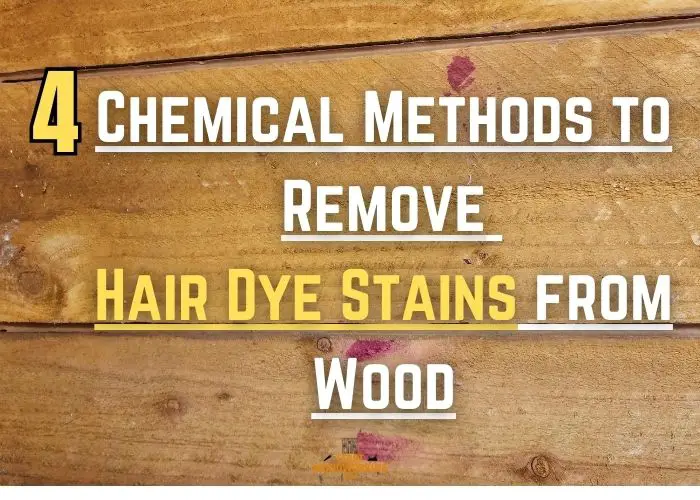
1. Using Hairspray
Step 1: Test the Hairspray on a Small Section of Wood
I always start by testing the hairspray on a small, hidden section of the wood to ensure it doesn’t damage the finish or color of the wood.
Step 2: Apply the Hairspray to the Dye Stain
I spray a generous amount of hairspray directly onto the hair dye stain, ensuring the area is well-coated. This step should be done in a well-ventilated area to avoid inhaling fumes.
Step 3: Allow to Hairspray to Act
I let the hairspray sit on the stain for a few minutes. This gives the alcohol time to penetrate and start breaking down the hair dye molecules.
Step 4: Wipe the Hair Dye Stain
Using a clean, soft cloth, I gently wipe the stain in the direction of the wood grain. The dye should start transferring onto the cloth. I may need to reapply hairspray and wipe a few times for tougher stains.
Step 5: Clean the Wood Area
Once the stain is lifted, I clean the wood with a damp cloth to remove any residue from the hairspray, then dry it thoroughly with a towel to prevent any moisture damage.
Step 6: Buff the Wood
If the wood’s finish looks a bit dull after this process, I’ll buff it with a dry cloth to restore its shine.
Pros:
- Alcohol Content: Hairspray typically contains alcohol, which can effectively break down the molecules in the hair dye, making it easier to wipe away the stain.
- Readily Available: Hairspray is a common household item, so it’s convenient to use without the need for a special trip to the store.
- Quick Action: This method can work quickly, especially on fresh stains, reducing the time the dye has to set into the wood.
- Ease of Use: The application is straightforward—simply spray and wipe, which is manageable for most people without specialized skills.
Cons:
- Potential Damage to Finish: Hairspray can contain various chemicals in addition to alcohol that might harm the wood’s finish, especially if it’s an antique or uses a delicate finish.
- Residue: Some hairsprays might leave a sticky residue that requires additional cleaning, which could be time-consuming or potentially damage the wood if not done properly.
- Limited Effectiveness: Depending on the type of hair dye and the wood’s finish, hairspray might not be effective at removing all of the stain.
2. Using Nail Polish Removal
Step 1: Select the Right Nail Polish Remover
I always opt for an acetone-based nail polish remover because acetone is a strong solvent that’s effective at breaking down hair dye pigments. However, it’s potent and can potentially damage the wood finish, so it should be used with caution.
Step 2: Perform a Spot Test
Before applying it to the visible stain, I find an inconspicuous spot on the wood to test the nail polish remover. This ensures that it won’t strip the wood’s finish or alter its color. I apply a small amount with a cotton swab and observe any adverse reactions.
Step 3: Apply the Remover on the Hair Dye Spot
If the spot test is successful, I take a clean, white cloth and lightly dampen it with nail polish remover. I avoid soaking the cloth to prevent the acetone from penetrating too deeply and causing damage to the wood.
Step 4: Gently Blot the Stain
With the dampened cloth, I carefully blot the dye-stained area, starting from the edges and working inward. This technique helps prevent spreading the stain further. I use a light touch to minimize the risk of the finish being removed along with the dye.
Step 5: Repeat if Necessary
If the hair dye stain persists, I reapply nail polish remover to a fresh area of the cloth and continue blotting. It’s important to be patient and persistent, as some stains may require several attempts to fully remove.
Step 5: Neutralize the Wood Area
After the stain is lifted, I promptly clean the wood with a damp cloth to remove any remaining acetone, which could continue to affect the wood’s finish if left unchecked.
Step 6: Dry and Buff the Wood Surface
Finally, I dry the wood thoroughly with a clean, dry cloth. If the finish looks dull or affected, I might buff the area with a wood polish to restore its natural sheen and protect the surface.
Pros:
- Strong Solvent: Acetone is a powerful solvent that can break down the chemical structure of hair dye, making it effective at removing or significantly lightening stains.
- Fast-Acting: Nail polish remover often works quickly to dissolve the stain, which can be especially helpful if you’re dealing with a fresh spill.
- Accessibility: Nail polish remover is a common household item, which makes it a convenient option without the need for specialized cleaning products.
Cons:
- Potential Damage: Acetone can strip away the finish from the wood along with the dye, especially if the wood is not properly sealed or if the finish is delicate.
- Toxicity: Acetone fumes can be harmful if inhaled, and the product should be used in a well-ventilated area with care taken to avoid skin contact.
3. Baking Soda and Hydrogen Peroxide
Step 1: Create the Cleaning Paste
I start by making a paste with equal parts baking soda and hydrogen peroxide. The consistency should be similar to toothpaste—thick enough to cling to the wood without running. Baking soda acts as a mild abrasive to lift the stain, while hydrogen peroxide has bleaching properties that can break down the dye.
Step 2: Test the Mixture
Before applying it to the stain, I test the paste on a small, inconspicuous area of the wood to ensure it doesn’t damage the finish or alter the wood’s color. I look for any adverse reactions, like discoloration or damage to the wood’s sealant.
Step 3: Apply the Paste to the Dye Stain
Once I’ve confirmed the paste is safe to use, I apply it directly onto the hair dye stain using a spatula, spoon, or a gloved finger. I spread it evenly over the stain, ensuring full coverage.
Step 4: Allow Time to React
I let the paste sit on the stain for several minutes. The duration can depend on the severity of the stain; however, I generally recommend between 5 to 30 minutes. During this time, the hydrogen peroxide works to lighten the dye, and the baking soda helps to absorb it.
Step 5: Gently Scrub the Area
With a soft-bristled brush or a cloth, I gently scrub the stained area in a circular motion, working with the wood grain. This helps to lift the dye from the wood without causing scratches or damage.
Step 6: Rinse and Dry
After scrubbing, I wipe away the paste with a damp cloth, rinsing the area thoroughly to ensure all residue is removed. Then, I dry the wood completely with a clean towel to prevent any water damage or warping.
Step 7: Condition the Wood
After the stain is removed, I often treat the wood with a suitable wood conditioner or polish to restore its natural luster and protect the surface.
Pros:
- Gentle on Wood: Baking soda is a mild abrasive, which means it’s less likely to scratch or damage the wood’s surface compared to harsher abrasives.
- Effective Bleaching: Hydrogen peroxide acts as a mild bleach, which can lighten or remove the color of the hair dye without the harshness of stronger chemical bleaches.
- Non-Toxic: Both baking soda and hydrogen peroxide are more environmentally friendly and non-toxic compared to other chemical stain removers, making them safer to use in a household setting.
- Readily Available: These ingredients are commonly found in most homes, making this method convenient and cost-effective.
Cons:
- May Require Multiple Applications: Depending on the severity of the stain, this method may need to be repeated several times to fully remove the dye.
- Potential for Lightening Wood: While hydrogen peroxide is a mild bleach, there’s still a risk it could lighten the wood itself, especially if the wood is dark or has a delicate finish.
- Slow Acting: This method may take longer to see results compared to stronger chemical removers, requiring patience and time.
4. The Pink Stuff
Step 1: Apply The Pink Stuff
If the test area shows no damage, I apply a small amount of The Pink Stuff directly onto the hair dye stain. Using a soft cloth or sponge, I spread the paste evenly over the stain, ensuring it’s thinly coated. It’s important not to use too much force or over-apply the product, as this could cause unnecessary wear on the wood’s finish.
Step 2: Gentle Scrub the Hair Dye Stain
With the paste in place, I gently scrub the stain in a circular motion, following the grain of the wood. The Pink Stuff’s formulation includes fine abrasive particles that help lift the stain without the need for excessive pressure, which could scratch the surface.
Step 3: Wipe Clean
After scrubbing, I immediately wipe the wood with a damp cloth to remove any residue of The Pink Stuff. It’s essential to do this promptly, as leaving the paste on for too long might lead to a dulling of the wood’s finish.
Step 4: Rinse and Dry
I rinse the area with a clean, damp cloth to ensure all traces of the cleaning paste are gone, and then I follow up with a dry towel to absorb any moisture. This step is vital to prevent water damage or warping of the wood.
Step 5: Repeat if Necessary
If the stain is still visible, I might repeat the process, being careful not to overdo it to protect the integrity of the wood’s finish.
Step 6: Polish the Wood
Once satisfied with the stain removal, I polish the area with a suitable wood polish to restore its natural sheen and provide a protective layer to the wood’s surface.
Pros:
- Effective Cleaning Power: The Pink Stuff is known for its ability to tackle a wide range of stains, including stubborn ones like hair dye, due to its abrasive components that can lift and remove the dye from the wood surface.
- Versatile Use: It’s a versatile cleaner that can be used on various surfaces, not just wood, making it a handy product to have in your cleaning arsenal.
- Eco-Friendly: Compared to some harsh chemical cleaners, The Pink Stuff is less toxic and more environmentally friendly, which is a significant advantage for those looking to use safer cleaning alternatives.
Cons:
- Abrasive Nature: While its mild abrasiveness is effective for cleaning, there is a risk of damaging the wood’s finish if used too vigorously or too frequently. Always use it with care and perform a spot test first.
- Potential for Residue: If not thoroughly rinsed off, The Pink Stuff can leave a residue on the wood that may require additional cleaning to remove.
- Limited on Certain Finishes: It may not be suitable for all types of wood finishes, particularly those that are more delicate or can be easily worn away by abrasives.
Useful Tips to Prevent Hair Dye Stains on Wood Surfaces
As a professional woodworker with expertise in maintaining wood surfaces, preventing hair dye stains is often easier and more effective than dealing with the removal afterwards. Here are the most useful tips for preventing hair dye stains on wood surfaces:
- Cover Surfaces: Before dyeing hair, cover your wood surfaces with a plastic sheet, old towels, or newspapers. This acts as a barrier between the dye and the wood, catching any spills or splatters.
- Use Protective Sealants: Regularly apply a protective sealant to your wood surfaces, such as a polyurethane coating, to create a barrier that can prevent hair dye and other substances from penetrating the wood grain.
- Immediate Clean-Up: In case of any accidental spills, wipe them up immediately with a damp cloth before the dye has a chance to set. The longer a dye sits on wood, the harder it will be to remove.
- Dye Hair Away from Wood: If possible, choose a location for dyeing hair that is away from wooden furniture or floors, such as in a bathroom with tiled surfaces that are easier to clean.
- Use Hair Dyeing Accessories: Utilize tools like hair dyeing capes, applicator bottles with narrow tips, and gloves to reduce the risk of splashing or spilling dye.
- Apply a Barrier Cream: Before dyeing hair, you can apply a thin layer of petroleum jelly along the edges of your wood surfaces. This can act as a repellant to prevent dye from sticking.
- Keep Cleaning Supplies Handy: Have cleaning supplies ready, such as rubbing alcohol or a dedicated stain remover, so you can address any stains immediately if they occur.
For older hair dye stains, you may need to use a stronger cleaning agent, like rubbing alcohol or a specialized wood cleaner. If the stain persists, gently sanding the area with fine-grit sandpaper and refinishing it might be necessary.
The safest method is to start with the gentlest cleaning solutions, such as a mixture of dish soap and warm water, and use a soft cloth to dab at the stain. Always test any cleaning solution on an inconspicuous area first to ensure it doesn’t damage the finish.
Sanding can remove the stain if it’s on the surface, but it’s not always the best solution, as it will also remove the wood’s finish and may require refinishing. It’s best reserved for severe stains and should be done carefully to avoid damaging the wood.
It depends on the method used to remove the stain and the extent of the cleaning. If the finish has been damaged or if the area has been sanded down, refinishing will be necessary to restore the wood’s protective layer and appearance.

